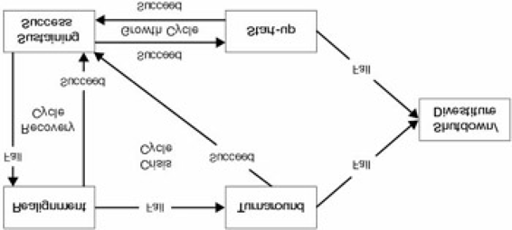The First 90 Days (19 page)
Authors: Michael Watkins
Tags: #Success in business, #Business & Economics, #Decision-Making & Problem Solving, #Management, #Leadership, #Executive ability, #Structural Adjustment, #Strategic planning



Diagnosing the Business Situation
The four broad types of business situations that new leaders must contend with are start-up, turnaround, realignment, and sustaining success. (From now on we will refer to this framework of transition types as the STARS model.) An outline of the characteristics of each of these types, and their associated challenges and opportunities, will help you to recognize the key structural features of your own situation.
What are the defining features of each of the four STARS situations? In a
start-up
you are charged with assembling the capabilities (people, funding, and technology) to get a new business, product, or project off the ground. In a
turnaround
you take on a unit or group that is recognized to be in trouble and work to get it back on track. Both start-ups and turnarounds involve much resource-intensive construction work— there isn’t much existing infrastructure and capacity for you to build on. To a significant degree, you get to start fresh. But both require that you start making tough calls early.
Realignments and sustaining-success situations, by contrast, are situations in which you enter organizations that have significant strengths, but also serious constraints on what you can and cannot do. In
realignment,
your challenge is to revitalize a unit, product, process, or project that is drifting into trouble. In a
sustaining-success
situation, you are shouldering responsibility for preserving the vitality of a successful organization and taking it to the next level. Put another way, in realignments you have to reinvent the business; in sustaining success situations, you have to invent the challenge. In both situations, you typically have some time before you need to make major calls, which is good news because you have to learn a lot about the culture and politics and begin building supportive coalitions.
Applying these categories to business situations is useful regardless of your level in the organization. You may be a new CEO taking over an entire company that is in start-up mode. Or you could be a first-line supervisor managing a new production line, a brand manager launching a new product, an R&D team leader responsible for a new product-development project, or an information technology manager responsible for implementing a new enterprise software system. All of these situations share the characteristics of a start-up. Turnovers, realignments, and sustaining-success situations also arise at all levels, in companies large and small.







Understanding the History
The relationships among these four business situations are depicted in the STARS model of business evolution shown
in figure 3-1
. The key point is that businesses (and, for that matter, projects, processes, products, and plants) tend to move predictably from one type of situation to another. Understanding the history of your new organization will help you grasp the challenges and opportunities of your situation.
Figure 3-1:
The STARS Model
Let us start, fittingly, with start-ups. Successful start-ups grow and eventually become sustaining-success situations.
Often the individuals who managed the start-up move on to tackle new start-ups, and managers more experienced at running larger businesses take over. These successful businesses may in turn give birth to internal start-ups as they diversify into new products, services, processes, or technologies. In this way, healthy companies enter a
growth cycle
.
But entropy increases. Successful businesses tend, because of internal complacency or external challenges or both, to drift toward trouble. Even if the organization is not yet in crisis, acute observers see gathering storm clouds that signal a need for realignment. This was the situation facing Claire Weeks, who failed to recognize it early enough.
Realigning an organization usually means redirecting its resources, such as by abandoning aging product lines and developing new technologies. It often means changing the organization’s strategy, structure, skills, and even its culture in fundamental ways. Realigning the business returns it to a sustaining-success state, designated in the model as the
recovery cycle
. One of the main hurdles of realignment is that many in such organizations, like Claire Weeks, are in denial about the situation. They continue to believe they are sustaining success even as they are heading for trouble.
If efforts to realign the business fail, it can end as a full-scale turnaround. This happens when prior leaders failed to see the need for realignment. (After all, businesses rarely go directly from sustaining success to turnaround.) No matter why this happened, there is rarely argument about the need to make big changes fast if the situation is dire, the business is losing money, and its best talent is jumping ship. Turning around a failing business requires the new leader to cut it down to a defendable core fast and then begin to build it back up. This painful process, if successful, leaves the business in a sustaining-success situation, as illustrated by the
crisis cycle
in figure 3-1
. If efforts to turn around the business fail, the result is shutdown or divestiture.
